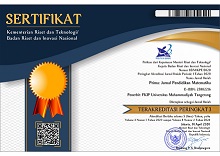STUDENTS NUMERICAL LITERACY ABILITY IN PROBLEM BASED LEARNING WITH ETHNOMATEMATICS NUANCES
Abstract
One of the approaches/methods used in learning to improve students' numeracy literacy skills is using Problem Based Learning (PBL). The use of PBL in learning is used for various purposes, starting from increasing mathematical abilities, mathematical communication, and students' numeracy literacy skills. In order for learning to be more meaningful, learning is associated with the culture in the surrounding environment. Ethnomathematics is the term that refers to the combination of culture and mathematics. However, in reality learning mathematics is still centered on the teacher. Innovative learning models are not used by teachers. The purpose of this study was to assess the efficacy of the PBL model with ethnomathematics nuances in improving students' numeracy literacy skills. A quasi-experimental research method was utilized in this study, with one experimental group. As a result, the design employed by the researchers was a one group pretest posttest design. The research sample consisted of 37 students, class IV with saturated sample technique. The type of instrument is a description test. The study's findings demonstrate an improvement and development in the average numeracy literacy skills. Therefore, the application of the PBL model with ethnomathematics nuances can improve students' numeracy literacy skills.
Keywords
Full Text:
PDFReferences
Abdullah, D, I., Mastur, Z., & Sutarto, H. 2015. "The Effectiveness of Learning ModelsProblem Based Learning Ethnomatematic Nuances on Students' Problem Solving Ability."Unnes Journal Of Mathematics Education, 4(3): 285–91. https://journal.unnes.ac.id/sju/index.php/ujme/article/view/9056.
Ambarwati, D., & Kurniasih, M. D. 2021. “InfluenceProblem Based Learning Helped by Youtube Media for Students' Numerical Literacy Ability."Scholar's Journal: Journal of Mathematics Education,5(3): 2857–2868. https://doi.org/10.31004/cendekia.v5i3.829.
Ashri, D. N., & Pujiastuti, H. 2021. "Numerative Literacy in Integrated Thematic Learning in Elementary School Grades."Journal of Mathematics Education Works8(2): 1–7.
Darmayasa, J. B., Wahyudin, W., Mulyana, T., & Noto, M. S. (2018). Remembering the Hindu festivities mathematically by the Balinese using integer operations and the least common multiple. Journal of Physics: Conference Series, 1008(1). https://doi.org/10.1088/1742- 6596/1008/1/012057
Dwi, I. M., Arif, H. & Sentot, K. 2013. "The Influence of ICT-Based Prolem Based Learning Strategies on Understanding Concepts and Ability to Solve Physics Problems .”Journal of Indonesian Physics Education9(1). https://journal.unnes.ac.id/nju/index.php/JPFI/article/view/2575.
Fajriyah, Euis, Mulyono, and M Asikin. 2020. “Mathematical Literacy Ability Reviewed from Cognitive Style of Students on Mind Mapping Learning Model with Constructivism Approach.” Unnes Journal of Mathematics Education Research 8(1): 57–64. https://journal.unnes.ac.id/sju/index.php/ujmer/article/view/30452.
Geni, P. R. L., Hidayah, I., & Zaenuri. 2017. "Student Problem Solving Ability in LearningProblem Based Learning Ethnomatematics Nuances Viewed From Cognitive Style."Journal of Mathematics Education Research. 6(1): 11–17. https://journal.unnes.ac.id/sju/index.php/ujmer/article/view/17232.
Hendriana, H., Johanto, T., & Sumarno, U. 2018. “The Role Of Problem-Based Learning To Improve Students’ Mathematical Problem-Solving Ability And Self Confidence.” Journal on Mathematics Education 9(2): 291–300. https://ejournal.unsri.ac.id/index.php/jme/article/view/5394.
Ministry of Education and Culture. 2017. "Numeration Literacy Support Material."Ministry of Education and Culture8(9): 1–58.
Nahdi, D. S., Jatisunda, M. G., Cahyaningsih, U., & Suciawati, V. 2020. “Pre-Service Teacher’s Ability in Solving Mathematics Problem Viewed from Numeracy Literacy Skills.” Elementary Education Online. https://doi.org/10.17051/ilkonline.2020.762541.
Prabawati, N, M. 2016. "Ethnomathematics of the Rajapolah Weaving Craftsmen Society, Tasikmalaya Regency."Scientific Journal of Mathematics Study Program STKIP Siliwangi Bandung5(1): 25–31.
Santoso, Ni., Waluya, B., & Sukestiyarno. 2013. "Problem Solving Ability in Mathematics Learning with Master Strategy and Application of Scaffolding."Unnes Journal of Mathematics Education Research 2(2): 69–75. https://journal.unnes.ac.id/sju/index.php/ujmer/article/view/2683.
Sugiyono. 2010.Educational Research Methods. London: ALPHABETA.
Suharsaputra, U. (2014).Quantitative, Qualitative, and Action Research Methods.Bandung: PT Refika Aditama.
Trianto. 2007.Constructivist Oriented Innovative Learning Models. Jakarta: Library Achievement.
Widiastuti, E. R., & Kurniasih, M. D. 2021. "Influence of ModelsProblem Based Learning Using Cabri 3D V2 Software on Students' Numerical Literacy Ability."Scholar's Journal: Journal of Mathematics Education,5(2): 1687–1699. https://doi.org/10.31004/cendekia.v5i2.690.
Yusuf , M , W. , Saidu , I. , & Halliru , A. 2010 .Internasional Journal Of Mathematical Science Education 3(1):36–42.https://www.researchgate.net/publication/265710203 Ethnomathematics a% 0Amathematical_game_in_Hausa_culture.
DOI: http://dx.doi.org/10.31000/prima.v7i2.8387
Article Metrics
Abstract - 1543 PDF - 1278Refbacks
Prima: Jurnal Pendidikan Matematika
Program Studi Pendidikan Matematika
Fakultas Keguruan dan Ilmu Pendidikan
Universitas Muhammadiyah Tangerang
Jl. Perintis Kemerdekaan I/33, Cikokol
Kota Tangerang, Indonesia
e-mail: primajpm@gmail.com
Prima: Jurnal Pendidikan Matematika (p-ISSN: 2579-9827 | e-ISSN: 2580-2216) is licensed under a Creative Commons Attribution 4.0 International License.







